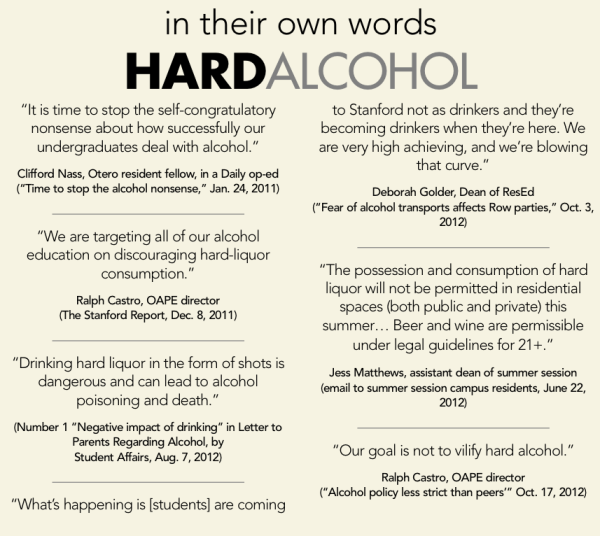
“We have a health and education approach right now,” said Deborah Golder, dean of residential education. “We have an expectations approach, and that feels very congruent with Stanford’s culture and values.”
The emphasis on educating students will take the form of increased programming by the Office of Alcohol Policy and Education’s (OAPE) Cardinal Nights initiative, now entering its second year. Despite an uptick in medical alcohol transportations last year, OAPE declared Cardinal Nights’ first year to be a success in creating a community for non-drinkers on campus.
The OAPE will also focus on altering the social dynamic of freshman dorms by a series of targeted alcohol talks offered with the assistance of the Office of Sexual Assault and Relationship Abuse (SARA), as well as launching a pilot program in the Wilbur residential complex that encourages residential staff to be more active in promoting responsible approaches to alcohol.
“Freshmen are a higher risk group,” said Ralph Castro, OAPE director. “We need to develop a system that will educate them on what they’re going to be experiencing in college and to create safety nets in case there are problems.”
While the University’s ban on the storage and consumption of hard alcohol during this past Summer Session prompted a backlash from students and resident assistants (RAs) alike, Golder and Castro quickly distanced themselves from the policy, noting that current RAs received additional training with regards to alcohol-related issues.
“We’ve heard that feedback,” Castro said, noting that – despite research linking hard alcohol consumption to medical incidents – attempts by other schools to ban hard alcohol have been largely unsuccessful. “Our goal is not to vilify hard alcohol. Our goal is to reduce behavior that gets people hurt.”
“I found the [residential] staff very receptive,” Golder added.
Castro added that the increased freshman outreach is intended to be a proactive effort to defend against a national trend of growing high-risk drinking, and framed the transition as the least repressive measure available to the University.
“It’s obviously not just a question for Stanford – it’s a question for higher education,” Golder said, noting the Stanford currently participates in a national collaborative on high-risk drinking. “If we don’t respond to trends, there will be a crisis – it’s inevitable – and we won’t have done everything we could to prevent a tragedy from occurring.”
Cliff Nass, resident fellow in Otero, said that the increased dialogue between Otero RAs and students has thus far been unequivocally productive, adding that he was “guardedly optimistic” that the increased outreach might offer a solution to high-risk drinking without banning hard alcohol.
“Given what I’ve seen, I would loosen that stance [of advocating banning hard alcohol],” Nass said. “I don’t think hard alcohol serves Stanford well, but I don’t think it has to be banned.”
Castro and Golder emphasized the campus-wide nature of the issue of high-risk drinking, noting this year’s provision of substance-free housing in Mirrielees and encouragement of freshman outreach by Greek societies as evidence of the diverse range of policies required to confront the issue.
“There’s never a one-size-fits-all answer at Stanford,” Golder said.
Meanwhile, the start of this academic year also marked the introduction of more stringent policies regulating alcohol at Stanford’s peer institutions.
At Dartmouth, a scandal over fraternity hazing and drinking practices has been reflected in unannounced walkthroughs of Greek organizations as well as the obligation for athletes and first-time alcohol-related offenders to go through an alcohol education and counseling program. Students involved in risky alcohol behavior may also be referred to the program by residential student staff.
“We have had a range of responses to our clarifications of our [student staff] role, but most have been positive,” wrote Aurora Matzkin, special assistant to Dartmouth’s president, in an email to The Daily. “Some express gratitude for the clarifications to their role and the new reporting tools they now have to connect a student in need to additional assistance.”
Matzkin acknowledged that the program’s implementation was too recent to draw any comprehensive conclusions, but cited previous success in a pilot stage as grounds for the program’s expansion.
“Given the other existing research on this program, we are now focused on delivering this intervention to more students in a timely fashion,” Matzkin wrote.
Harvard also introduced more stringent regulation on undergraduate drinking this academic year, although the program awaits faculty review. While restrictions on hard liquor were loosened for off-campus events, Harvard will implement increased scrutiny of private events on-campus and the prohibition of “activities that promote high-risk drinking,” while sustaining a ban on hard liquor at on-campus registered social events.
“While alcohol has a role in social activities, its role is ancillary to our mission and purpose as a College,” wrote Harvard spokesman Jeff Neal in an email to The Daily. “It is expected that hosts will plan parties where drinking is not the central activity.”
Yale, meanwhile, has made no direct changes in recent years to a stringent alcohol policy that, among other aspects, prohibits all kinds of alcohol in freshman residences. Hannah Peck, a student affairs fellow at Yale College, defended Yale’s sustained policy.
“We are working hard to make sure our students have the best learning environment possible,” Peck wrote in an email to The Daily. “We do our best to help students make decisions that will point their lives in a positive direction.”
Reviewing Stanford’s stance, Golder framed the reliance on constructive dialogue between students and administrators in formulating an approach to alcohol as a credit to the University’s character, but acknowledged that a continued rise in alcohol-related incidents would likely prompt a change in policy towards the more stringent model encountered at peer institutions.
“[The current policy] requires more from us as citizens of the University…[but] if things continue to trend in a high-risk way, of course we’ll keep looking at it,” Golder said.
“The good news is that we’re really committed,” Nass reflected. “We’re trying stuff – that’s the Silicon Valley approach.”

